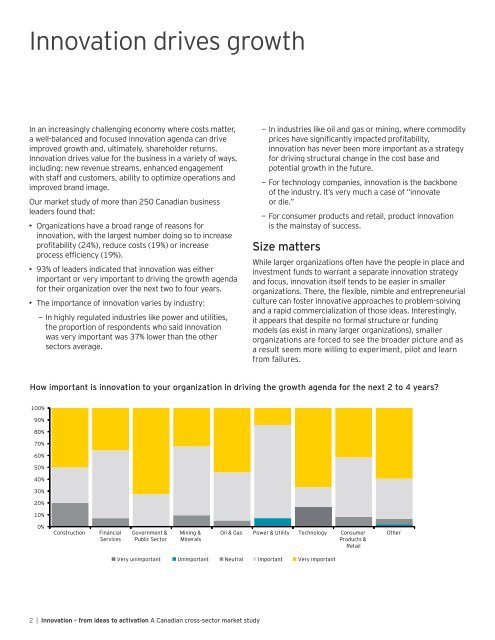Innovation from ideation to activation
Innovation-from-ideation-to-activation
Innovation-from-ideation-to-activation
Create successful ePaper yourself
Turn your PDF publications into a flip-book with our unique Google optimized e-Paper software.
<strong>Innovation</strong> drives growth<br />
In an increasingly challenging economy where costs matter,<br />
a well-balanced and focused innovation agenda can drive<br />
improved growth and, ultimately, shareholder returns.<br />
<strong>Innovation</strong> drives value for the business in a variety of ways,<br />
including: new revenue streams, enhanced engagement<br />
with staff and cus<strong>to</strong>mers, ability <strong>to</strong> optimize operations and<br />
improved brand image.<br />
Our market study of more than 250 Canadian business<br />
leaders found that:<br />
• Organizations have a broad range of reasons for<br />
innovation, with the largest number doing so <strong>to</strong> increase<br />
profitability (24%), reduce costs (19%) or increase<br />
process efficiency (19%).<br />
• 93% of leaders indicated that innovation was either<br />
important or very important <strong>to</strong> driving the growth agenda<br />
for their organization over the next two <strong>to</strong> four years.<br />
• The importance of innovation varies by industry:<br />
−−In highly regulated industries like power and utilities,<br />
the proportion of respondents who said innovation<br />
was very important was 37% lower than the other<br />
sec<strong>to</strong>rs average.<br />
−−In industries like oil and gas or mining, where commodity<br />
prices have significantly impacted profitability,<br />
innovation has never been more important as a strategy<br />
for driving structural change in the cost base and<br />
potential growth in the future.<br />
−−For technology companies, innovation is the backbone<br />
of the industry. It’s very much a case of “innovate<br />
or die.”<br />
−−For consumer products and retail, product innovation<br />
is the mainstay of success.<br />
Size matters<br />
While larger organizations often have the people in place and<br />
investment funds <strong>to</strong> warrant a separate innovation strategy<br />
and focus, innovation itself tends <strong>to</strong> be easier in smaller<br />
organizations. There, the flexible, nimble and entrepreneurial<br />
culture can foster innovative approaches <strong>to</strong> problem-solving<br />
and a rapid commercialization of those ideas. Interestingly,<br />
it appears that despite no formal structure or funding<br />
models (as exist in many larger organizations), smaller<br />
organizations are forced <strong>to</strong> see the broader picture and as<br />
a result seem more willing <strong>to</strong> experiment, pilot and learn<br />
<strong>from</strong> failures.<br />
How important is innovation <strong>to</strong> your organization in driving the growth agenda for the next 2 <strong>to</strong> 4 years?<br />
100%<br />
90%<br />
80%<br />
70%<br />
60%<br />
50%<br />
40%<br />
30%<br />
20%<br />
10%<br />
0%<br />
Construction<br />
Financial<br />
Services<br />
Government &<br />
Public Sec<strong>to</strong>r<br />
Mining &<br />
Minerals<br />
Oil & Gas Power & Utility Technology Consumer<br />
Products &<br />
Retail<br />
Other<br />
Very unimportant Unimportant Neutral Important Very important<br />
2 | <strong>Innovation</strong> – <strong>from</strong> ideas <strong>to</strong> <strong>activation</strong> A Canadian cross-sec<strong>to</strong>r market study


